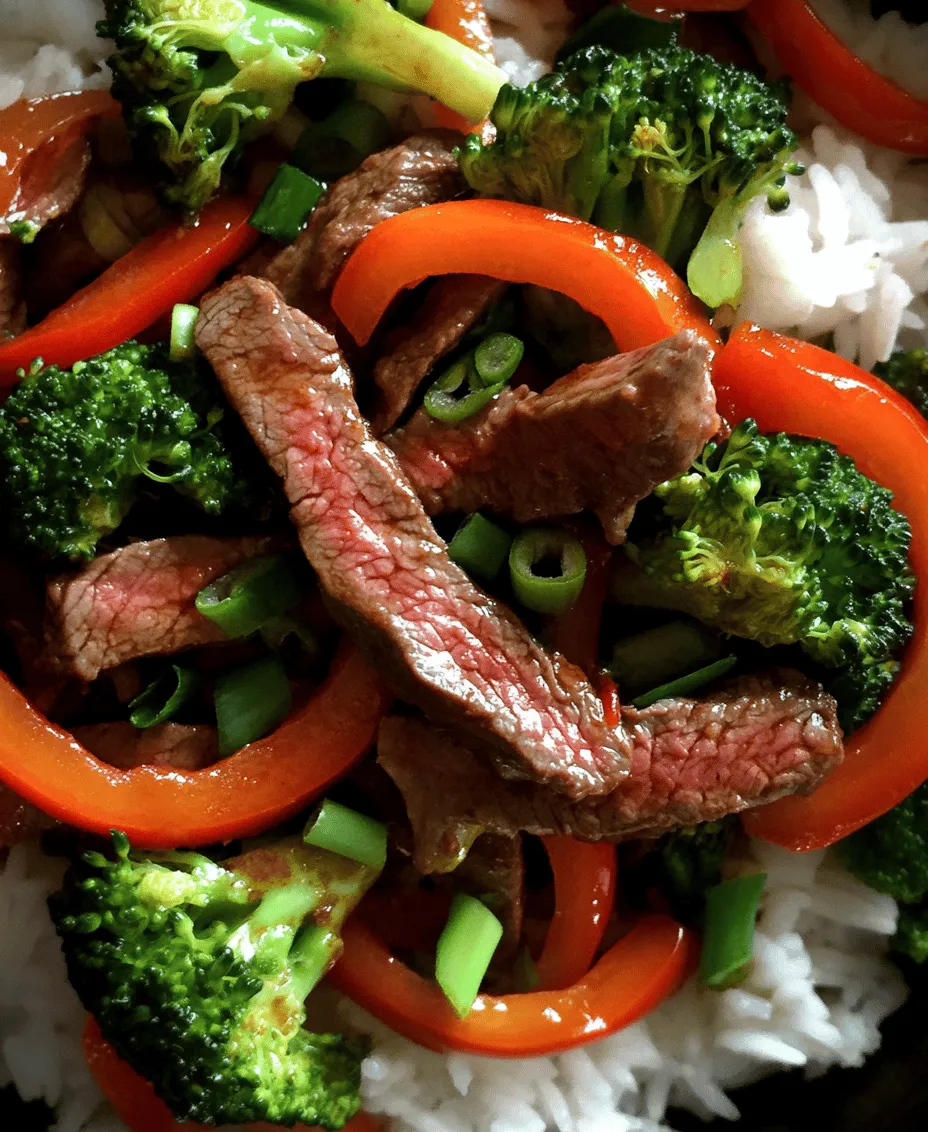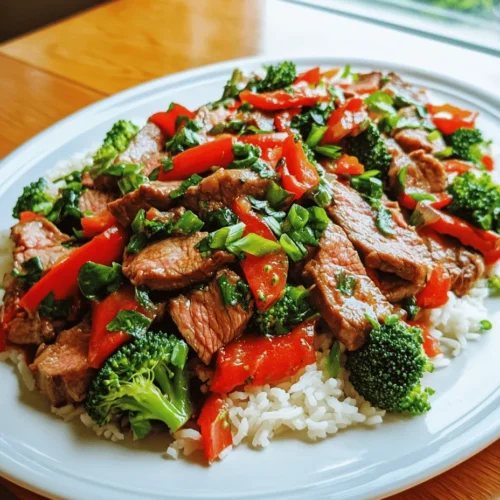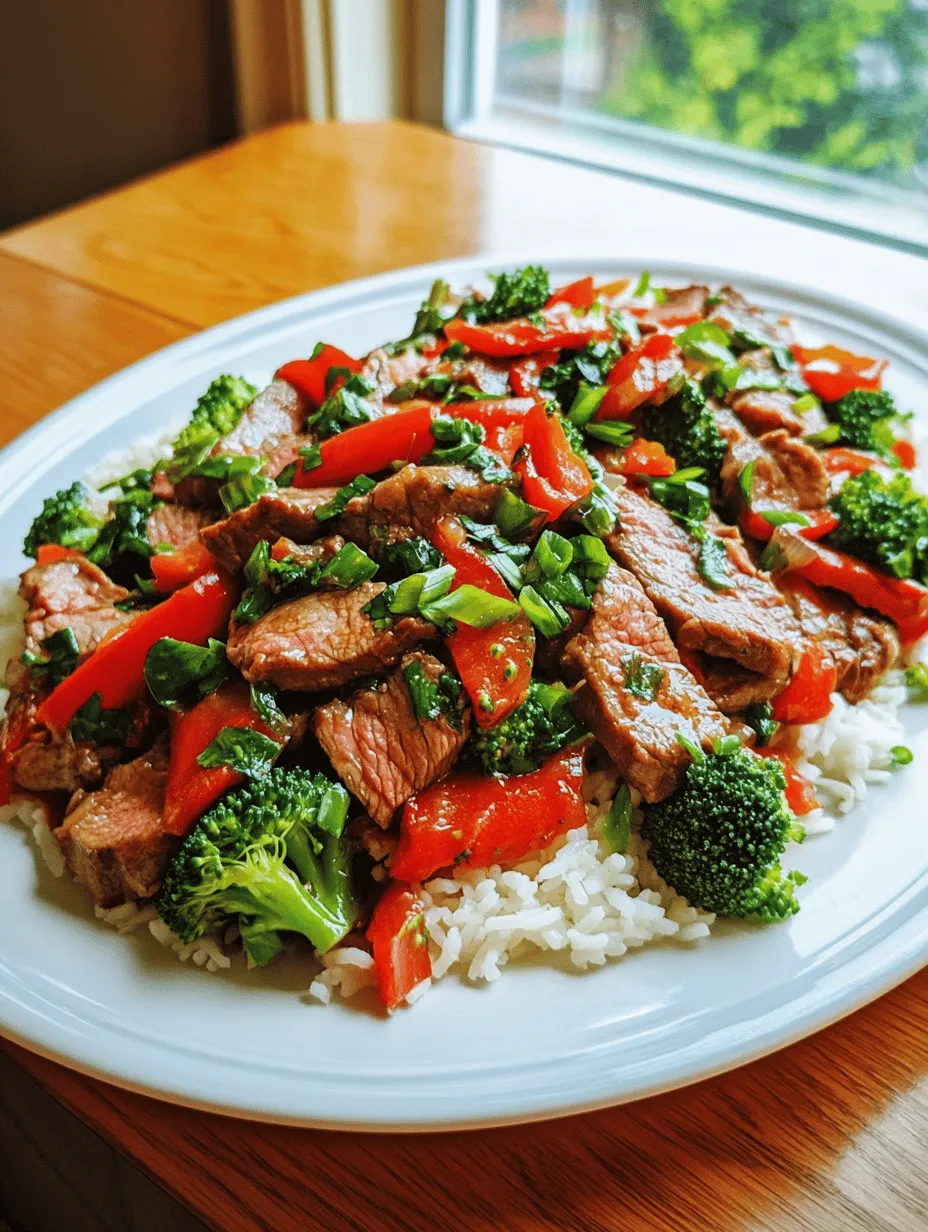Introduction
When it comes to quick, satisfying meals that burst with flavor, few dishes can compete with a classic stir-fry. The Savory Beef Delight with Oyster Sauce is a standout recipe that combines tender beef, vibrant vegetables, and the umami richness of oyster sauce, creating a dish that is both delicious and visually appealing. This recipe not only highlights the beauty of Asian cuisine but also showcases how simple ingredients can come together to create a culinary masterpiece.
Using fresh ingredients is paramount in achieving the best flavors in this dish. The crispness of fresh vegetables, the juiciness of premium beef, and the depth of flavor from high-quality sauces are what set this recipe apart from others. At the heart of this dish is oyster sauce, a staple in Asian cooking that elevates the flavor profile of any meal. Its savory sweetness complements the natural flavors of the beef and vegetables, enhancing the overall taste experience.
Understanding the Ingredients
Beef Sirloin: The Star of the Dish
To achieve the perfect stir-fry, selecting the right cut of beef is crucial. Beef sirloin is often the preferred choice for this recipe due to its balance of flavor and tenderness. Sirloin is a lean cut that, when cooked correctly, remains juicy and flavorful. Its slightly firmer texture holds up well in stir-frying, allowing it to absorb the delicious sauces while maintaining a satisfying chew.
When selecting your beef, look for cuts that are bright red with a fine grain. Freshness is key; if the meat is dull in color or has an off smell, it’s best to choose another cut. For the best results, slice the beef thinly against the grain, which helps to break down the muscle fibers and results in a more tender bite.
The Significance of Oyster Sauce and Soy Sauce
Oyster sauce is a cornerstone of many Asian dishes, and its addition to this stir-fry is what gives it a distinctive flavor. Made from oyster extracts, this sauce is rich, savory, and slightly sweet, making it an excellent pairing for beef. It acts as both a marinade and a finishing sauce, amplifying the dish’s umami taste and adding complexity to the overall flavor.
Soy sauce, another essential ingredient, complements the oyster sauce by providing a salty depth. Together, these sauces create a rich base that enhances the natural flavors of the beef and vegetables. When using soy sauce, opt for low-sodium varieties to maintain control over the saltiness of the dish, allowing the other flavors to shine through.
The Role of Cornstarch in Marinating and Texture
Cornstarch plays a key role in achieving the desired texture in your stir-fry. It not only helps to marinate the beef but also creates a light coating that seals in moisture during cooking. This process results in beef that is both tender and juicy, with a glossy finish that looks appealing on the plate.
When marinating, the cornstarch helps to create a protective barrier that prevents the meat from drying out. This is particularly important in stir-frying, where high heat can quickly overcook the beef. By incorporating cornstarch into your marinade, you ensure that the beef retains its moisture and flavor, resulting in a more enjoyable eating experience.
Aromatics: Garlic and Ginger
No stir-fry is complete without aromatic ingredients, and in this recipe, garlic and ginger take center stage. These two ingredients not only provide a fragrant base for your dish but also offer numerous health benefits. Garlic is known for its immune-boosting properties, while ginger aids in digestion and adds a warming, spicy note.
When preparing the dish, it’s important to finely mince the garlic and ginger to release their essential oils and flavors. Sautéing them briefly before adding the beef will infuse the oil, creating a flavorful foundation that enhances the overall dish.
Nutritional Benefits of Broccoli and Bell Pepper
The vegetables in this stir-fry, namely broccoli and bell pepper, are not just for color; they also contribute nutritional value. Broccoli is a powerhouse of vitamins K and C, fiber, and antioxidants, making it an excellent addition to any meal. Its slightly bitter flavor contrasts beautifully with the savory notes of the beef and sauces.
Bell peppers, on the other hand, add a sweet crunch to the dish. Packed with vitamin C and various antioxidants, they not only enhance the flavor but also boost the dish’s health benefits. Using a mix of red, yellow, or green bell peppers can also add visual appeal, making your stir-fry more enticing.
The Importance of Seasoning with Salt and Pepper
Seasoning is a crucial step in any cooking process, and it’s no different when preparing your Savory Beef Delight with Oyster Sauce. Salt and pepper are the foundational seasonings that enhance the flavors of your ingredients. While oyster and soy sauces provide a base of saltiness, a pinch of salt can help bring out the natural flavors in the beef and vegetables.
When seasoning, be mindful of the salt content in your sauces. Start with a small amount of salt, and adjust to taste as you cook. Freshly cracked black pepper adds a subtle heat and depth that elevates the overall dish without overpowering it. Balancing these seasonings is key to achieving a harmonious flavor profile.
Marinating the Beef
Step-by-Step Process of Marinating Beef for Optimal Flavor
Marinating beef is an essential step in achieving a tender and flavorful dish. For the Savory Beef Delight with Oyster Sauce, a simple marinade of oyster sauce, soy sauce, cornstarch, and a touch of salt and pepper is all you need. Here’s a step-by-step guide to preparing your marinade:
1. Combine the Ingredients: In a mixing bowl, add 2 tablespoons of oyster sauce, 1 tablespoon of soy sauce, and 1 tablespoon of cornstarch. Stir until the cornstarch is completely dissolved.
2. Slice the Beef: Thinly slice your beef sirloin against the grain. Aim for slices that are about 1/4 inch thick to ensure quick cooking and tenderness.
3. Marinate the Beef: Add the sliced beef to the marinade, ensuring each piece is well-coated. Cover the bowl with plastic wrap or transfer it to a resealable bag to minimize air exposure.
4. Let it Rest: Allow the beef to marinate for at least 30 minutes at room temperature or up to 2 hours in the refrigerator. The longer the beef marinates, the more flavor it will absorb, making it tender and juicy.
Importance of Marination Time: Effects on Tenderness and Taste
Marination time is critical for two main reasons: flavor infusion and tenderness. Allowing the beef to sit in the marinade gives the flavors time to penetrate the meat. The cornstarch also works to create a protective layer, locking in moisture.
If time permits, marinating for a longer period—up to several hours—will enhance the flavor further, making every bite more enjoyable. However, avoid marinating for more than 24 hours, as the meat may become mushy due to the acidic nature of the sauces.
Tips for Choosing the Right Beef Cut
When it comes to selecting the right beef cut for your stir-fry, there are a few options to consider. Besides sirloin, other great choices include flank steak, ribeye, or tenderloin. Each cut offers different textures and flavors, so choose one that fits your preference:
– Flank Steak: This cut is flavorful and relatively lean, making it a popular choice for stir-frying. Slice it thinly against the grain for the best results.
– Ribeye: Known for its marbling and tenderness, ribeye adds rich flavor to the dish. However, it may be higher in fat, which can enhance flavor but requires careful cooking to avoid greasiness.
– Tenderloin: This is the most tender cut of beef, making it ideal for quick cooking methods like stir-frying. It is also the most expensive option, so consider your budget when choosing.
Ultimately, the key to a successful stir-fry lies in the quality of your beef. Look for cuts that are fresh, well-marbled, and free from excessive fat. Your choice will significantly impact the dish’s flavor and texture, so select wisely.
Preparing the Stir-Fry
Essential Cooking Equipment: Skillet vs. Wok
The choice of cooking equipment can influence the outcome of your stir-fry. While both a skillet and a wok can be used for this recipe, each has its advantages. A wok, with its high sides and rounded bottom, is traditionally used in Asian cooking and allows for even heat distribution. This design helps to quickly sear the beef and vegetables while retaining their crispness.
If you don’t have a wok, a large skillet can work just as well. The key is to ensure that your pan is large enough to accommodate all the ingredients without overcrowding. Overcrowding can lead to steaming rather than stir-frying, resulting in a less desirable texture.
Importance of Heating Oil Properly for a Good Sear
Before you begin cooking, it’s essential to heat your oil properly. Using a high smoke point oil, such as vegetable or peanut oil, is ideal for stir-frying. Heat the oil in your skillet or wok over medium-high heat until it shimmers but does not smoke.
Properly heated oil is crucial for achieving that coveted sear on your beef. When the oil is hot enough, it creates a barrier that helps to lock in moisture, allowing for a flavorful crust to form on the surface of the meat. It also prevents the beef from sticking to the pan, making for easier cooking and cleanup.
Techniques for Sautéing Aromatics without Burning
Once the oil is heated, it’s time to introduce your aromatics. Start by adding the minced garlic and ginger to the pan. The goal is to sauté them until fragrant—this usually takes about 30 seconds to a minute. Be vigilant during this step, as garlic can burn quickly and develop a bitter flavor.
To sauté without burning, continuously stir the aromatics and keep an eye on the heat. If you notice the garlic beginning to brown too quickly, reduce the heat slightly or remove the pan from the heat for a moment. This technique will help you achieve a flavorful base for your stir-fry without compromising on taste.
Cooking the Beef to Perfection
Best Practices for Searing Beef: Ensuring Browning and Flavor
After sautéing the aromatics, it’s time to add the marinated beef to the pan. Spread the beef in an even layer to ensure even cooking and browning. Avoid overcrowding the pan; if necessary, cook the beef in batches. This allows the meat to sear rather than steam, resulting in a more flavorful dish.
Allow the beef to cook undisturbed for the first minute to develop a nice sear. Once browned, use a spatula to flip the beef and continue cooking for another minute or two, just until it’s no longer pink in the center. The goal is to achieve a golden-brown crust while keeping the interior tender and juicy.
Timing for Cooking Beef: Avoiding Overcooking
Timing is critical when cooking beef in a stir-fry. Depending on the thickness of your slices, it should only take 3 to 5 minutes to cook through. Keep in mind that overcooking can lead to dry, tough meat, so it’s essential to monitor it closely.
As the beef cooks, it will change color from red to brown. To check for doneness, cut a piece in half to ensure it’s no longer pink in the center. If you’re unsure, using a meat thermometer can help you determine if the beef has reached the desired internal temperature of 145°F (63°C) for medium-rare.
How to Season Beef at the Right Moment
Seasoning the beef at the right time can also enhance its flavor. Ideally, you want to season the beef with a sprinkle of salt and pepper just before it finishes cooking. This allows the seasoning to adhere to the surface and enhances the overall taste without overpowering the dish.
Once the beef is cooked to perfection, you can remove it from the pan and set it aside while you prepare the vegetables. This step ensures that the beef remains tender and juicy, ready to be combined with the colorful veggies and sauce for a delicious finish.
—
This article provides a comprehensive introduction and guide for preparing Savory Beef Delight with Oyster Sauce. Stay tuned for the next part, where we will delve into the cooking of the vegetables, combining all the ingredients, and serving suggestions to complete this delectable dish.

Sautéing the Vegetables
To create a vibrant and delicious Savory Beef Delight with Oyster Sauce, it’s essential to sauté the vegetables properly. The key to maintaining their bright colors and satisfying crunch lies in the cooking techniques you employ. Start by ensuring your wok or skillet is adequately heated before adding any ingredients. A preheated pan allows for quick cooking, which helps lock in nutrients and flavor while preventing sogginess.
When it comes to cooking times, different vegetables require varying lengths of time to reach that perfect tender-crisp state. For instance, bell peppers and snap peas typically need only 2-3 minutes, while carrots may take a little longer, around 4-5 minutes. Broccoli florets also benefit from a short cooking time; aim for about 3-4 minutes. The goal is to keep each vegetable vibrant and crunchy, so be vigilant and stir frequently.
Sometimes, adding a splash of water can be an effective steaming technique when sautéing. When you notice the vegetables starting to brown or stick to the pan, add a tablespoon or two of water. Cover the pan momentarily to trap steam, which will help cook the vegetables without losing their texture. This method works particularly well for denser vegetables, ensuring they become tender while still retaining their bright colors.
Combining Ingredients for Maximum Flavor
Timing is crucial when it comes to combining the beef with the sautéed vegetables. After the vegetables have reached their desired doneness, return the beef to the pan. This should be done just before the vegetables finish cooking to prevent the beef from overcooking. Overcooked beef can become tough and chewy, detracting from the overall dish.
Once the beef is back in the pan, use a spatula or tongs to toss the ingredients gently but thoroughly. This technique ensures that the oyster sauce and seasonings coat every piece of beef and vegetable evenly. The goal is to achieve a harmonious blend of flavors without overcooking any components. Stir-fry the mixture for an additional 1-2 minutes, allowing everything to heat through while maintaining the integrity of the vegetables.
To ensure the dish is heated evenly without risking overcooking, keep the heat at medium-high. This will allow the oyster sauce to caramelize slightly, enhancing the dish’s flavor profile. Stir continuously to avoid any sticking and to create a delightful blend of textures.
Finishing Touches
The finishing touches are what elevate your Savory Beef Delight to the next level. Green onions serve as both a garnish and a flavor enhancer. They not only add a pop of color but also a fresh, crisp bite that complements the savory elements of the dish. Simply slice the green onions thinly and sprinkle them on top before serving.
If you want to intensify the flavor even further, consider adding a drizzle of extra oyster sauce right before serving. This optional addition can enhance the umami characteristics of your dish, making it even more irresistible.
Presentation is key when it comes to serving your Savory Beef Delight. Consider plating the dish with care, using a large shallow bowl or a plate to showcase the vibrant colors of the beef and vegetables. Arrange the stir-fry artfully, and for an eye-catching touch, you can serve it with a side of jasmine rice or noodles neatly arranged beside it.
Serving Suggestions
When it comes to serving Savory Beef Delight with Oyster Sauce, the choice of accompaniments can greatly influence the dining experience. Steamed jasmine rice is a classic pairing, providing a fluffy base that soaks up the flavorful sauce beautifully. Alternatively, noodles—whether rice noodles or egg noodles—add a delightful chewiness that complements the tender beef and crisp vegetables.
For those looking to customize the dish, consider incorporating additional ingredients such as mushrooms, bok choy, or baby corn. These additions not only enhance the flavor but also contribute to a more diverse texture and appearance.
Pairing beverages with your meal is another way to elevate the experience. For a refreshing contrast, serve the dish with a chilled green tea or a light lager. If you prefer something non-alcoholic, a sparkling water with a slice of lime can cleanse the palate between bites.
Nutritional Information
Understanding the nutritional value of your meal is essential for maintaining a balanced diet. Each serving of Savory Beef Delight with Oyster Sauce contains approximately 350 calories, with a breakdown of macronutrients as follows:
– Protein: 25g (primarily from beef)
– Carbohydrates: 30g (from vegetables and any accompanying rice or noodles)
– Fat: 15g (from cooking oil and oyster sauce)
In addition to being delicious, this dish boasts several health benefits. Beef is an excellent source of high-quality protein, essential for muscle growth and repair. The vegetables contribute vital vitamins and minerals, such as vitamin C from bell peppers and vitamin A from carrots, promoting overall health.
For those with dietary restrictions, this recipe can easily be adapted. To make it gluten-free, choose a gluten-free oyster sauce or substitute it with tamari. For a lower-calorie option, consider using lean cuts of beef or substituting beef with chicken or tofu.
Conclusion
Savory Beef Delight with Oyster Sauce is a versatile and appealing dish that can easily become a family favorite. Its vibrant colors, rich flavors, and satisfying textures make it an ideal meal for any occasion. As you prepare this dish, don’t hesitate to experiment with seasonal vegetables, incorporating whatever is fresh and available in your local market.
Cooking at home provides the opportunity to enjoy meals that are not only delicious but also made with love and care. Encourage your family to gather around the table and savor the hearty flavors of your homemade stir-fry. With a little creativity and a few simple techniques, you can transform everyday ingredients into a culinary masterpiece that everyone will adore. Enjoy the satisfaction of cooking and the joy of sharing delicious meals with loved ones.



